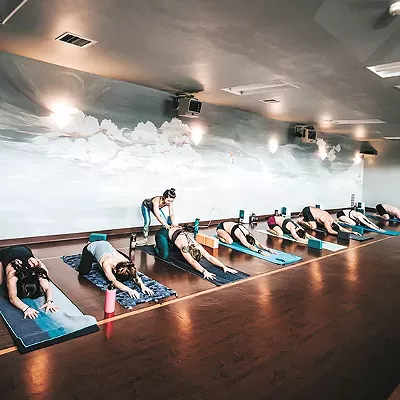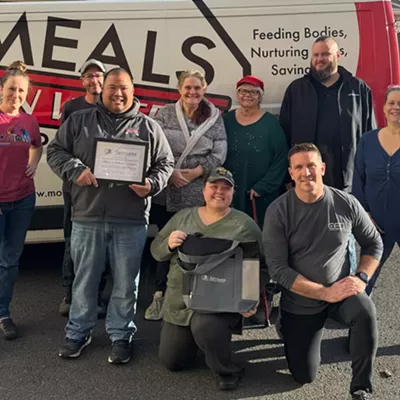I pass the smoothie bar and take the first door on the right. In a mildly cluttered little room, I enter a wooden box. As I sit there, I can see my reflection in the glass door — my left side bombarded by orange infrared light making my glistening visage look like something out of Blade Runner 2049.
And I am sweating.
The temperature is 140 degrees in the sauna at Wellness Tree in the South Perry District. For $45, I'm spending roughly 35 minutes in the confines of the hot box seeking a healthier self. Spokane isn't flush with sauna locations, but there are others to be found at various spas and gyms around the area. While saunas have long been lauded for health benefits such as loosening joints, improving blood flow and relieving mental stress, they're hardly the only way that extreme heat can be part of a better health plan.
Christopher Minson, a thermal physiologist and professor of human physiology at the University of Oregon, is on a quest to find those health benefits of extreme heat. Through the work of Minson and his academic research peers throughout the country, we're getting closer to figuring out when turning up the heat is actually the best practice.
"There's a lot of work going on right now. In the '40s and '50s, this explosion about research about exercise and benefits of exercise really took off," says Minson. "We're kind of there with heat therapy. We know it's good, we know it's important, but there just isn't enough research in all these different cases and situations. So I think over the next few years, we're going to start really seeing: What's the best therapy for this patient population? What's the best time for this population? What's the most easy use for that population? All that kind of stuff will really start coming out.
"In a lot of ways, the benefits from going to heat therapy are similar to those of exercise," says Minson. "And by no means would I say replace exercise with just heat therapy if people are able and willing to exercise. But we believe a lot of the benefits from exercise actually come from a rising body temperature."
While some of Minson's field of research is done in saunas like the one I found myself in, a large portion of the studies are conducted via hot water immersion — essentially people sitting in a hot tub (at 104 degrees Fahrenheit) for typically 45 minutes in order to raise body temperature to a certain sustained threshold, then repeating the immersion three to five times per week.
"So if we take someone who just goes into a hot room [or hot water immersion], a number of things happen," says Minson. "One is we know that, similar to exercise, their heart rate goes up. We know that their heart has to contract a little harder, we know that the way that blood is distributed in their body changes, we know that the way that blood flows through blood vessels is improved. And with an increase in body temperature, we know certain molecules get released as well.
"We call these general classifications of molecules heat shock proteins," Minson explains. "And these proteins have a lot of benefits throughout the body. They can help us to have reduced blood pressure. We can have more healthy blood vessels, decreasing the risk of things like atherosclerosis and arteriosclerosis.
"We've actually shown that we also see improvements in the handling of glucose or blood sugar in our bodies. There's even some evidence that it can help with injured muscles and other things. So there's a really wide range of benefits that we're seeing through the chronic use of heat stress."
Other benefits of spending sustained time in high heat have included better sleep habits, and the potential for growth in the field is tantalizing. Minson is collaborating with researchers who hope to find positive benefits for people with severe spinal cord injuries, diabetes and even Alzhiemers. A 20-year sauna study in Finland saw decreases in everything from cardiovascular mortality to Alzheimer's from consistent sauna usage, essentially the more visits per week the better.
For people looking to start heat therapy, there are an increasing number of personal saunas, inflatable hot tubs and other products on the market. Minson and his peers have yet to find a minimal effective dose of heat but suggest people need to raise their body temperature at least 1 degree Fahrenheit to see the heat stress benefits. He recommends people, especially older individuals, have their cardiovascular health checked before self-medicating with heat. And then it's also crucial to listen to your body. Start slow, maybe five- to 10-minute increments, and then build up tolerance.
"I use a typical scale from zero meaning 'I'm perfectly thermoneutral — not hot and not cold' and 10 is 'I am really extremely hot. I've got to get away from whatever I'm in right now.' We want people like a six or a seven, right?" says Minson. "'I'm feeling the heat, I'm definitely not uncomfortable, but I'm feeling very hot. I'm sweating and I could feel my heart rate up a little bit.'
"Humans have this incredible ability to adapt to heat," Minson continues. "So as long as you start slow and remain hydrated, during and after and throughout the day, and you aren't trying to do too much too fast. It's a very, very safe way to go."
I'm by far the least in-shape person in a dark, steamy room on this chilly Tuesday evening. I'm also the only one wearing a shirt. It soon becomes evident why that is a mistake. I do my best to keep my balance while grabbing my right knee to my chest, but my lightheaded self is wobbling like a toddler's toy.
And I am sweating. Good lord, am I ever sweating.
The temperature is 105 degrees with 65 percent humidity in the studio at Beyoutiful Hot Yoga on the South Hill. I've dropped into a hot hatha yoga class, the recommended entry-level offering from the regional chain (which also boasts North Spokane, Spokane Valley, Coeur d'Alene, and Wenatchee locations — $29 for a drop-in class, $150/month for a membership).
The 60-minute class consisting of the same 28 positions every time is designed to test the strength, flexibility and balance of all participants. On this evening, I can roughly get through about 65 percent of it, spending the remaining time recovering and toweling myself off. I finally feel dry again maybe two hours later.
But here's the thing: Exercising in extreme heat conditions was not at all a miserable experience. Employing heat for your health needn't be a sedentary venture, it can also be a workout. Hot yoga offers intense exercise, but one that can also hit levels of relaxation that pumping iron or running on a treadmill wouldn't provide.
"Once the body is able to withstand that heat, and get more accustomed to it, it allows us to go into that parasympathetic nervous state [the network of nerves that relaxes the body after stress or danger]," says Jessie Jo Skala, who's been a yoga instructor at Beyoutiful for about two-and-a-half years after training on the West Coast of India. "For somebody that might have not done it before, sometimes the heat can put the body in more of a fight/flight mode. So once we're able to get that down we're in more control of our bodies and our vagus nerve. I think that's a huge thing with the hot yoga — that when we put ourselves in a stressful situation, we're able to adapt a little more easily."
Heated workout environments like the hatha class or other Beyoutiful offerings like power yoga and inferno hot Pilates provide a space to get in shape with improved circulation and increased flexibility thanks to your muscles being heated. While the humidity might leave you feeling sticky, it actually helps the body stay cool in the extreme environment. It's still vital to not push past one's limits (no ignoring pre-existing injuries!) and staying hydrated is crucial, but it can be enjoyed by a wide range of folks. Skala's oldest student was 87 years old (and she's still trying to convince her dad to take up hot yoga).
"We really try to emphasize welcoming everyone, no matter what body shape or what condition you're in."
"Just being in that room is like having a sauna membership somewhere," says Skala. "It's good just for the body, whether you're laying down in a horizontal position for the whole time, that's nothing to be ashamed of. It offers benefits from anyone from a beginner to an advanced yoga practitioner. We really try to emphasize welcoming everyone, no matter what body shape or what condition you're in."
"We like to say at the studio, 'The practice is not a workout, it's a work-in,'" continues Skala. "To enhance your physical capabilities, but as well tap into your mental capabilities and true potential."
And while that might sound a bit hippie dippy to certain folks, Minson and his research compadres are also diving into how heat can improve athletic performance, and they're seeing plenty of positive benefits. The world of heat health might just be opening, but for most people it's better than the polar opposite.
"Heat tends to be better than cold," Minson states. "[Cold stress] is not nearly as well studied at this point as heat; there's definitely some benefits to it.
"But people just don't like to be cold."♦
























